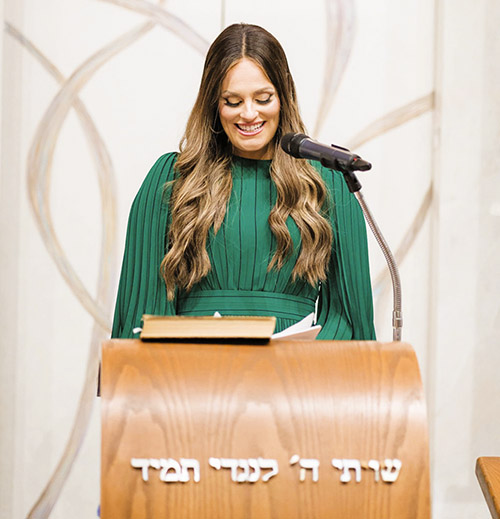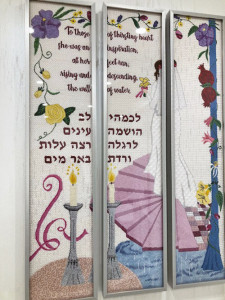

Fair Lawn’s Mikvah Chava Faiga, an elegantly refurbished mikvah six years in the planning, is finally open. In a word, it is stunning. Just ask anyone who has seen it. It was truly a community project and, as detailed in a recent Jewish Link article, so many lay and religious leaders volunteered their time, effort, vision and expertise to see it to fruition. Two women, though, deserve a special hakarat hatov.
Chaya Birnbaum, the driving force behind the enhancement, had been taught by her mother to always do each mitzvah in a joyful way. The mitzvah of taharat hamishpacha became a particularly meaningful one for her. As she shared, “Everyone has their causes, and this one was mine.” When she moved to Fair Lawn seven years ago she felt the mikvah, which had endured rigorous usage for nearly 30 years, was ready for a facelift. She explained her concerns and offered suggestions to those in a position to assist, determined to remake it to the highest of standards. She hasn’t disappointed.

As project manager, Birnbaum has been involved in nearly every aspect of the upgrade, working with a talented and tireless team. The project was particularly gratifying since the mikvah was named after her mother and dedicated to the memory of both her parents. At the formal ceremony, she reflected on their memories, saying, “For me, the joy of my mother and the humility of my father are the perfect complement to this project.” She spoke of how it takes a village, but she was particularly grateful to Dorya Barth and Susan Perlmutter for their design input, Rabbi Avrohom Bergstein for his wisdom in the role of rabbinic liaison, and Mikvah USA for their financial support and overall guidance.
In the end, it wasn’t the packed house and rousing dedication that was most meaningful to Birnbaum, but what quietly occurred behind the scenes. She said that she had asked a friend along while checking on the mikvah shortly before its completion. As her friend took everything in, she exclaimed, “I can’t wait to go to the mikvah.” Birnbaum explained that the mitzvah of taharat hamishpacha is not an easy one for everyone, and hearing her friend’s enthusiasm was the realization of her goal. Her other goal was also accomplished when she learned that six women made use of the mikvah the night it reopened, far above the average.
Then there’s Shevi Yudin. If Birnbaum represents enhancement, then Yudin represents foundation. Even before the shul Shomrei Torah was completed, the cement foundation for the mikvah had already been poured under the watchful guidance of Rabbi Benjamin and Rebbetzin Shevi Yudin.

Yudin has accompanied nearly every kallah from her shul to the mikvah and brought many of them and others to her home to teach them the laws of taharat hamishpacha. A visit to the mikvah prior to their wedding night was an opportunity for the rebbetzin to present new brides with a rose. She taught life-cycle classes in various yeshivot and high school groups, and girls as young as eighth grade would be introduced by her to the mikvah with a personal tour. Afterwards, all would be provided with a Dunkin’ Donut so that their introduction to the mikvah would be remembered as a” sweet experience.” Given the difficulty of securing a mikvah lady for Friday nights and Yom Tovim, Yudin has taken on the role since the mikvah’s inception in 1989. Carefully adhering to the concept of modesty, the rabbi would often delay a Friday night meal at their home when they had guests—which was essentially always—with a dvar Torah while the rebbetzin made sure to attend to any woman in need of the mikvah that night. The rabbi would cover for her, simply saying that his wife was getting ready for the meal and would join them shortly.
Given Shevi Yudin’s decades of commitment to ensure that every current and future kallah has a positive first exposure to this special mitzvah, it’s not surprising that the thought of a tangible reminder of her contribution was raised. Nechama Zofan, president of the Fair Lawn Mikvah Association when it was initially formed, got the ball rolling by reaching out to Yudin’s longtime friend Debbie Friedman for ideas. The decision was to create a three-panel needlepoint which would include all the elements of a mikvah. Ahuva Winslow, art director at Frisch, produced the original drawing, followed by the meticulous efforts of Pearl Frank, Sarah Gerstley and Dena Heller, three local needlepoint experts, to turn it into a true work of art. Its home is the mikvah’s waiting room, and it is the sole original piece of art in the mikvah complex. The plaque beneath reads, in part, “Just as rain from the heavens fills the mikvah as a symbol of purification, fertility and growth, Shevi has devoted over 30 years to filling the hearts and minds of countless women with comfort and encouragement for this important ritual.”
Robert Isler is a marketing research analyst and freelance writer. He can be reached at [email protected]













